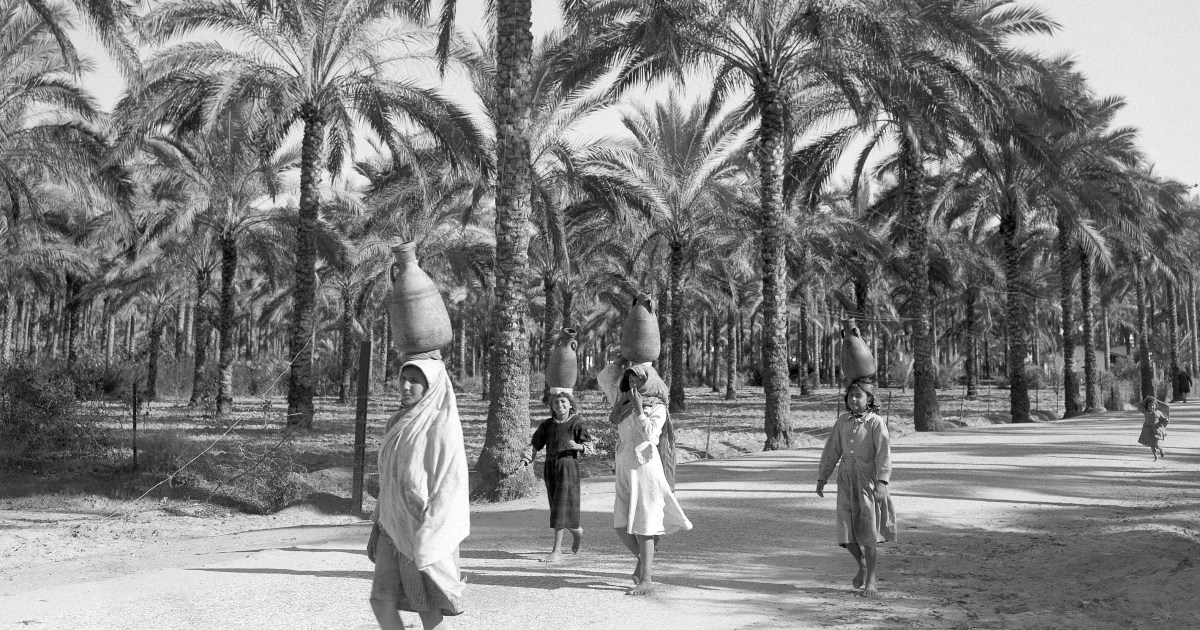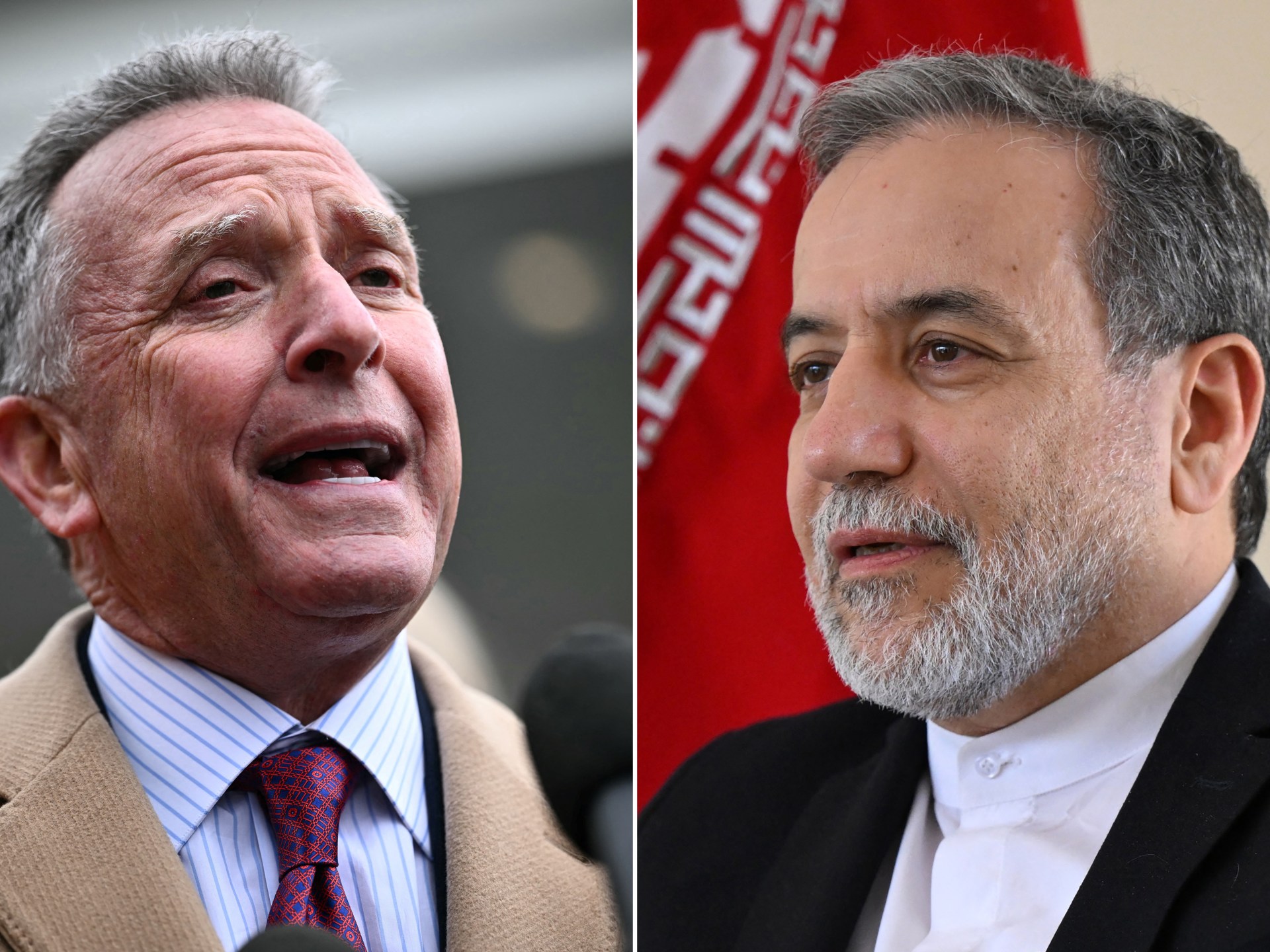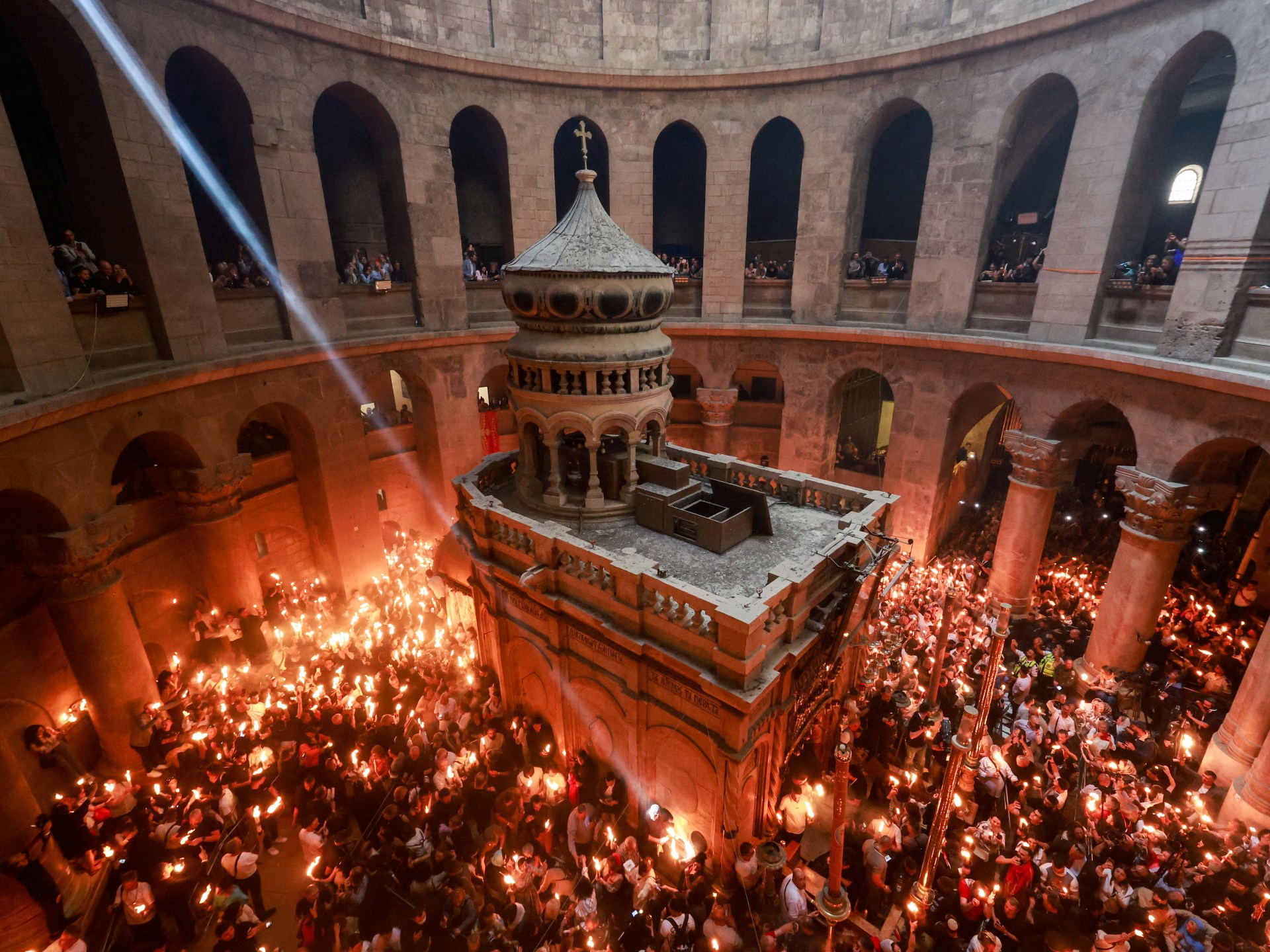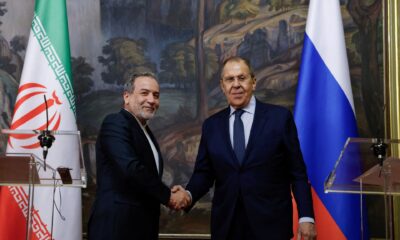Middle East
Sudan’s army seizes control of central bank amid steady gains in Khartoum | Sudan war News

The capture of the bank comes a day after Sudanese army forces celebrated the seizure of the presidential palace.
The Sudanese army claims to have seized control of the main headquarters of the country’s central bank from the paramilitary Rapid Support Forces (RSF) as it continues to make advances in the capital.
Nabil Abdallah, an army spokesman, said in a statement to the AFP news agency on Saturday that the soldiers had “eliminated hundreds of militia members who tried to escape through pockets in central Khartoum”.
The bank’s takeover comes a day after the army seized control of the presidential palace in a significant military victory.
But the RSF retaliated to Friday’s takeover with a drone attack that killed three journalists and several army personnel.
Army sources told AFP that RSF fighters on Friday fled into buildings in al-Mogran, an area west of the palace housing banks and business headquarters.
In the area, paramilitary forces posted snipers in high-rises that overlook the city of Omdurman across the Nile River and the ministries in central Khartoum.
However, the battle for the government and the financial district could strengthen the army’s hold on the capital and give it a significant advantage in the conflict.
Reporting from Khartoum, Al Jazeera’s Hiba Morgan said the army had been making “steady gains” in the past few months.
“They’ve been taking ground from the Rapid Support Forces in the northern part of the capital, in the eastern part of the capital, but there are still areas where the RSF are present and these are specifically around the western part of the country,” Morgan said.
“Effectively, where this leaves Sudan right now is divided into two, with the army controlling the eastern, northern and parts of the southeast, and the RSF controlling the western and southwestern parts of the country,” she added.
Since April 2023, the military, led by army chief Abdel Fattah al-Burhan, has been in an ongoing conflict with the RSF, headed by Burhan’s former deputy commander, Mohamed Hamdan Daglo.
But the two-year-long conflict has left the country in a deep humanitarian crisis, with tens of thousands of people killed and more than 12 million people displaced.
Middle East
The Hawaii of Israel: How Trump legitimised a longstanding Israeli vision | Israel-Palestine conflict

On April 7, United States President Donald Trump met Israeli Prime Minister Benjamin Netanyahu for a second time since his inauguration. Speaking to the media, Trump doubled down on his earlier comments about the Gaza Strip, describing it as an “incredible piece of important real estate”.
Trump also repeated his suggestion that the Palestinians should leave the Strip “to different countries” and claimed that people “really do love that vision. … A lot of people like my concept.”
Days later, about 70 percent of Gaza had been turned into a “no-go zone” for Palestinians. Confirming that Israel is working “in accordance with the US president’s vision, which we seek to realise”, Israeli Defence Minister Israel Katz declared Israel’s intention to “seize” more territory, adding that “wilful passage” will be given to Palestinians who want to leave.
It is by now clear that Trump’s statements on Gaza have had the effect of legitimising a longstanding Israeli vision of ethnic cleansing of the Strip. What the US president calls “my concept” is in fact not his at all.
Over decades of Israeli occupation and colonisation of the Gaza Strip, there have been multiple plans to empty out or disperse the Palestinian population in a bid to secure full control over this part of Palestine. The power of colonial practices has also been tested. For example, to draw Israeli settlers and thereby help transform Gaza’s demographics, the Strip was at one point even promoted as the “Hawaii of Israel”.
Left out of Israeli war aims in the 1948 Arab-Israeli War, the Gaza Strip emerged out of the 1949 Armistice Agreements under Egyptian military rule. Constituting only a small part of what until then had been the Gaza District of Palestine, the Gaza Strip was home to two groups of Palestinians: the local population and refugees – people who had been forced off their land as Israel expanded its territorial reach during the war.
As the guns fell silent, the Gaza Strip became known in Israeli policy circles as the “job unfinished” – a slice of land next to the Egyptian border that Israel’s leaders would like to control, preferably without its Palestinian population.
Israel’s first attempt to take Gaza by force occurred in 1956. But under pressure from US President Dwight Eisenhower, Israeli Prime Minister David Ben-Gurion had no choice but to withdraw and put an end to the Israeli occupation. The botched attempt taught Israel an important lesson: To redraw the map of the Middle East and to make its territorial expansionist agenda a success, Israel needed American support and approval.
The 1967 Arab-Israeli War was far more successful in this regard. Through conquest and occupation, the Gaza Strip was brought under direct Israeli rule. This opened the door to revitalise “transfer” – the forced displacement and ethnic cleansing of Palestinians. Seen as both necessary and permissible or, in Ben-Gurion’s words, “an important humane and Zionist idea”, transfer was recognised as an effective tool to advance Zionist colonisation of Palestine.
In the following years, as noted by Palestinian historian Nur Masalha, transfer acquired different labels. These included “population exchange”, “Arab return to Arabia”, “voluntary emigration” and “rehabilitation” with different Israeli governments taking different approaches.
One approach was Defence Minister Moshe Dayan’s “open bridges”, which allowed Palestinians in Gaza to leave for other countries in search of work. Another was to open offices in Gaza’s refugee camps to organise and pay for travel and passports for Palestinians willing to “voluntarily migrate”, which in effect turned the Israeli Ministry of Foreign Affairs into a “global travel agency”. Regardless of the approach, Israel’s policy objective remained the same: to create a drive in Palestinians to leave the Strip.
“I want them all to go, even if they go to the moon,” Israeli Prime Minister Levi Eshkol said. Expressing Israeli frustration, Eshkol articulated the feeling of being stuck with what was considered the problem of Gaza. After all, only the Palestinian population there – and the sizeable refugee population in particular – stood in the way of full Israeli annexation.
In response to Israel’s Gaza “dilemma”, its politicians also looked for more comprehensive solutions. This led to an almost continuous flow of plans for the “rehabilitation” of Palestinians outside the Strip. Starting immediately after the 1967 war, a variety of potential destinations came up. These included the West Bank, the Sinai Peninsula, Iraq, or even as far afield as Canada and Australia.
Despite Israeli efforts and elaboration of plans – and much to the disappointment of Israel’s decision-makers – the initiatives came to naught as the number of Palestinians leaving the Strip remained limited. And given other considerations, including moral, legal and diplomatic ones, the plans to displace a large number of Palestinians from Gaza were left in the drawer.
But as Israeli politicians turned to examine their menu of choices in the post-October 7, 2023, era, “voluntary emigration”, or forced displacement, re-emerged. Gone was any sensitivity to international opinion and potential reactions. Instead, Trump has led the way, making statements on Gaza that in effect turn decades of Zionist ideology and practice into official American policy.
By means of his policy stance, the US president has legitimised a longstanding Israeli vision of ethnic cleansing in the Strip. In the process, his articulation of policy has moved ever closer to the strand of Revisionist Zionism that viewed Palestinians as aliens in their own land and, therefore, “transferable”.
In arguing that Palestinians need to go to make Israel and the region safe, Trump has departed from the internationally shared principle that Palestinians in the Gaza Strip – as elsewhere in the occupied Palestinian territory – have legitimate rights to self-determination in their land. As such, Trump brings to mind Revisionist Zionist ideologue Ze’ev Jabotinsky, who argued that “when the Arab claim is confronted with our Jewish demand to be saved, it is like the claims of appetite vs the claims of starvation” with “transfer” inextricably linked to Jewish rights to the land.
The cynical promises of a better future for people who are left with nothing but their land after a brutal war of erasure and plausible genocide must be taken seriously. The legitimacy Trump has given to Israeli plans poses a threat in the here and now, but it could also outlast his presidency.
That is because he has offered US presidential sanction of ethnic cleansing as an acceptable tool. This leaves the door open for Israel – in the near or distant future – to pursue “transfer”, “rehabilitation” and “voluntary emigration” of Palestinians, whether in Gaza or the West Bank.
Furthermore, the American president has repeatedly communicated US support for illegal land seizures and colonisation. Suggesting Gaza (and Greenland) could become “US territory”, he has reintroduced and validated ideas that most leaders of the world had put on the scrap heap of history.
Finally, Trump has shifted the US position away from the premise of working towards a two-state solution. In fact, considering his statements, there appears to be a fundamental disregard for Palestinians in Gaza and their collective right to self-determination.
Looking at current US policy against historical record, Trump’s “Riviera of the Middle East” seems a curious combination of Zionist ethnic cleansing under the “transfer” model and the colonial ideal of the “Hawaii of Israel”.
It is no wonder Trump has been cheered on by Israeli leaders as he calls for the forced depopulation of the Gaza Strip and its transformation into fully fledged colonial territory – annexed or otherwise. After all, Trump’s ideas follow in the footsteps of Zionist leaders from Ben-Gurion to Netanyahu, under whom transfer has been the preferred but diplomatically and legally challenging option all along.
With Trump going out in front, such challenges could turn into tomorrow’s opportunities. It remains the task of other states to stand up against Israeli-American normalisation of continued ethnic cleansing and colonial land grabs in Palestine.
The views expressed in this article are the author’s own and do not necessarily reflect Al Jazeera’s editorial stance.
Middle East
Everything you need to know about Iran-US nuclear negotiations | Features

Iran and the United States held “constructive” discussions over the Iranian nuclear programme.
The second round of Oman-mediated talks in Rome took place on Saturday, a week after the first session in Muscat, the Omani capital.
“Technical discussions” are now expected to begin on Wednesday in Oman, after which more high-level meetings will be held to move closer to an agreement.
So, what are these technical discussions? And is an agreement likely?
Here’s what you need to know:
What are these technical talks?
On Wednesday, working-level experts from both sides will begin discussing the inner workings of sanctions relief and how that relates to Iran’s nuclear programme.
The sanctions regimes imposed on Iran are complex and multilayered, and each layer has to be linked to a specific action or guarantee Iran is being asked to undertake with regard to its nuclear programme.
Three days after these talks, another round of high-level talks will be held in Muscat.
The last two rounds were indirect talks between Iran’s Foreign Minister Abbas Araghchi and US Special Envoy Steve Witkoff, passing messages through Omani Foreign Minister Badr Albusaidi.

How did we get here?
Officials are optimistic about the progress on talks that started with US President Donald Trump threatening Tehran with attacks if it did not negotiate.
In early March, Trump said he had written to Iran’s Supreme Leader Ayatollah Ali Khamenei, asking for talks on the country’s nuclear programme.
But the letter was sent via the United Arab Emirates, and UAE presidential diplomatic adviser Anwar Gargash delivered it nearly a week after Trump’s announcement.
After saying Trump’s letter had not been received yet, Khamenei declared Iran would not accept the “demands” of “bully governments”.
But something thawed in the normally icy relations, and Iran agreed to indirect talks after Omani mediation.
Interestingly, Oman was also the mediator for the initial secret talks between Iran and the US that led to the JCPOA.

Does Iran want a nuclear weapon?
Iran has given no indication that it plans to build a nuclear weapon. In fact, the supreme leader has issued a religious decree years ago prohibiting the pursuit of such a weapon.
When Trump’s threats escalated, Khamenei said if Iran chooses to pursue a nuclear weapon, nobody could stop it. However, he has not reversed his decree prohibiting it.
Wasn’t there a deal limiting Iran’s nuclear programme already?
There was. The 2015 Joint Comprehensive Plan of Action (JCPOA) was a diplomatic win for former US President Barack Obama’s administration.
Under the terms of the deal, Iran committed to regular inspections of its nuclear energy programme in return for relief on some Western sanctions.
However, criticising the agreement during his first term, Trump withdrew from the JCPOA in May 2018 and imposed punitive sanctions on Iran.

What does the US want exactly?
One thing that has come up in discussions is how much enriched uranium Iran has and at what level.
Enriched uranium is used for nuclear energy reactors, but that is usually enriched to between 3 and 5 percent.
According to the International Atomic Energy Agency, Iran has 274.8kg (605.8 pounds) of uranium enriched up to 60 percent, lower than the 90 percent enrichment needed for a weapon.
Under the JCPOA, Iran could enrich uranium up to 3.67 percent and keep a uranium stockpile of 300kg (661 pounds).
Witkoff has said 3.67 percent would be an acceptable level of uranium enrichment, which is the same as agreed on in the JCPOA under Obama.

So, why does Trump want another deal?
It is hard to read Trump’s mind.
But going by what he has said, he sees himself as a dealmaker willing to talk to anyone, even if he ends up with a deal similar to the last one.
He was supposedly influenced by Israel’s opinion when he said the JCPOA was a “bad deal” and left it in 2018.
Israel has long seen Iran as a foe, claiming it is secretly pursuing a bomb and is a bigger regional threat than Israel’s increasingly violent occupation of Palestine.
Israeli Prime Minister Benjamin Netanyahu was so invested that he dedicated part of his 2012 UN General Assembly address to drawing a cartoon bomb with “red lines” through it, to illustrate his point.
Since international inspections began, there has been consensus that Iran was sticking to the deal, although it has increased its enrichment levels since Trump’s withdrawal from the JCPOA.
So, is there going to be a deal?
It is too early to say.
There are promising signs, such as reports that the Iranian and US teams were in the same room for at least part of the second round of negotiations, and the progress made in technical talks.
Araghchi, according to the semiofficial Tasnim news agency, said: “We succeeded in reaching a better understanding on certain principles and goals.”
He posted on Saturday that “for now, optimism may be warranted but only with a great deal of caution”.
Iran has insisted that the US guarantee it will adhere to this agreement. For its part, the US has insisted that Iran halt the uranium enrichment it claims is necessary to run its nuclear energy programme.

Middle East
Thousands gather for centuries-old Holy Fire ceremony in Jerusalem | Jerusalem News

Thousands of Christians gathered in the cavernous Church of the Holy Sepulchre for a centuries-old Holy Fire ceremony.
Holding unlit candles, they packed into the sprawling 12th-century basilica built on the site where, according to tradition, Jesus was crucified and buried.
In near-total darkness, the Greek patriarch entered the Holy Edicule and emerged with two lit candles. The flame was passed from one candle to the next, the light overcoming the darkness in the rotunda. The flame was later transferred to Orthodox communities in other countries on special flights.
Eastern Orthodox Christians believe the light miraculously appears inside the Holy Edicule, built on the traditional site of Jesus’s tomb, while sceptics going back to the Middle Ages have dismissed it as a carnival trick for the masses.
Either way, the ceremony, which goes back at least 1,200 years, is a sight to behold. It has also ignited safety concerns.
In 1834, a frenzied stampede broke out in the darkened church, and the ruler of the Holy Land at the time barely escaped after his guards drew swords and hacked their way through the crowd, historian Simon Sebag Montefiore recounts in his history of Jerusalem. Some 400 pilgrims died in the melee, most from suffocation or trampling.
Israeli authorities have sought to limit participants in recent years, citing safety concerns. That has drawn protests from church leaders, who have accused them of upsetting the delicate, unwritten arrangements around Jerusalem’s holy sites known as the status quo.
On Saturday, there was a heavy military presence as thousands of worshippers passed through Israeli checkpoints to enter.
Some worshippers lamented that the turnout lacked numbers this year because of Israel’s 18-month war on Gaza. “The number of police is higher than the number of pilgrims,” said Adeeb Joude, key holder for the Holy Sepulchre.
Israel captured East Jerusalem, including the Old City with major sites sacred to Jews, Christians and Muslims, in the 1967 Middle East War, and annexed it in a move not recognised internationally. The Palestinians want East Jerusalem to be the capital of their future state.
The Old City has a long history of tensions between Israelis and Palestinians, among different religious groups that share its hilly confines and even within certain faiths. Perceived infringements on the status quo in the Church of the Holy Sepulchre have led to brawls between monks of different denominations.
Israel says it is committed to ensuring freedom of worship for Jews, Christians and Muslims, and has long presented itself as an island of tolerance in the Middle East.
In recent years, however, tensions have risen with the local Christian community, most of whom are Palestinian Christians, a population that has dwindled through decades of conflict as many have moved abroad.
-

 Education2 days ago
Education2 days agoHarvard’s battle with the Trump administration is creating a thorny financial situation
-

 Conflict Zones2 days ago
Conflict Zones2 days ago‘How do I live like this?’ asks Gaza boy who lost arms in Israeli attack | Gaza News
-

 Europe2 days ago
Europe2 days agoTrump’s ‘lone ranger’: How Steve Witkoff became the defacto point man on America’s foreign policy challenges
-

 Conflict Zones2 days ago
Conflict Zones2 days agoIran has ‘doubts’ about US intentions ahead of nuclear talks | Politics News
-

 Europe2 days ago
Europe2 days agoThe Trump administration says Europe is taking advantage of the US. That’s not exactly true
-

 Conflict Zones2 days ago
Conflict Zones2 days agoTrump says US may ‘pass’ on helping end war if Russia, Ukraine resist deal | Russia-Ukraine war News
-

 Middle East1 day ago
Middle East1 day agoTunisian court hands opposition figures lengthy jail terms | Human Rights News
-

 Lifestyle2 days ago
Lifestyle2 days agoSweets from the sky! A helicopter marshmallow drop thrills kids in suburban Detroit




